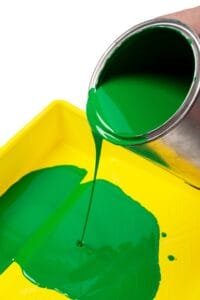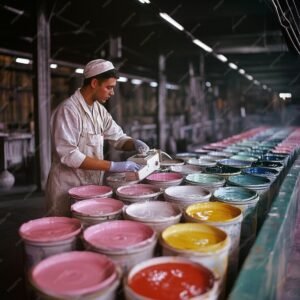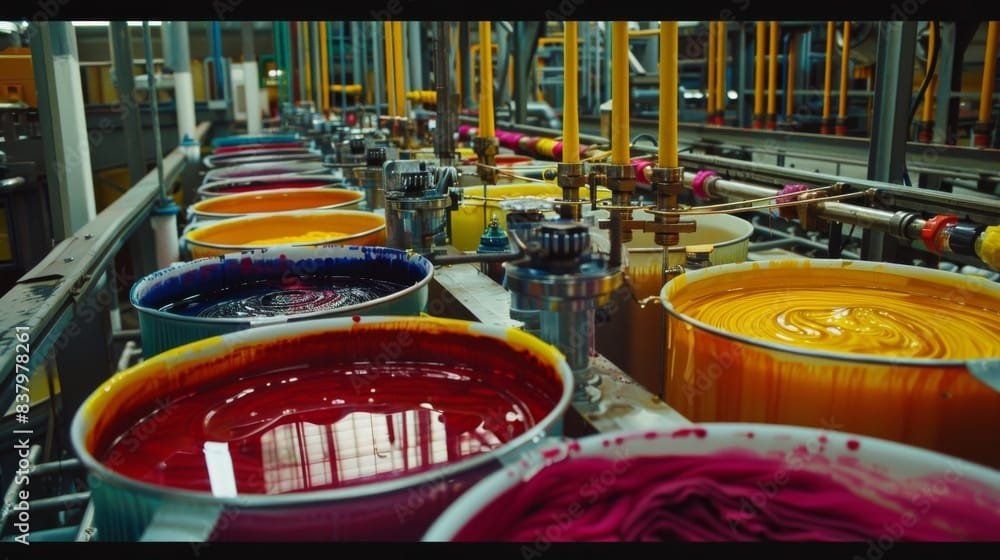Introduction to Sustainable Paint Manufacturing
As environmental concerns continue to escalate, the importance of sustainable paint manufacturing has grown significantly. This industry shift responds to a global demand for products that are not only high in quality but also environmentally responsible. Sustainable paint manufacturing emphasizes reducing harmful impacts on the planet by minimizing waste, using renewable resources, and implementing eco-friendly practices throughout the production process. These practices are essential in today’s context, where climate change and ecological degradation are at the forefront of public consciousness.
Mithila Paints exemplifies this shift towards sustainability by integrating eco-friendly principles into its operational framework. The company recognizes that traditional manufacturing methods can contribute to environmental issues, such as hazardous emissions and waste generation. Therefore, Mithila Paints has committed to adopting sustainable practices that ensure not only the quality of their products but also their commitment to the health of the environment. This dedication is evident in their choice of raw materials, production techniques, and packaging solutions.
In the paint industry, sustainability often involves using natural, non-toxic ingredients instead of volatile organic compounds (VOCs), which are harmful to both human health and the environment. Mithila Paints actively seeks to reduce its carbon footprint by employing these alternative materials, thus creating safer products for consumers and the planet alike. Furthermore, the company seeks to inspire and educate others about sustainable practices, pushing for a broader industry transformation toward eco-friendly operations.
In this blog post, we will explore the specific sustainable processes that Mithila Paints utilizes in their manufacturing operations, providing insights into how they are setting a benchmark for others in the industry. Understanding their approach can offer valuable lessons for both consumers and manufacturers seeking to navigate the complexities of sustainable production in the paint sector.
The Importance of Sustainability in the Paint Industry
Sustainability has become an essential aspect of manufacturing processes across various industries, including the paint sector. Traditional paint manufacturing often involves the use of harmful chemicals and solvents that can lead to significant environmental degradation. The production processes contribute to air and water pollution, as well as generate considerable waste. These environmental impacts not only harm natural ecosystems but also pose serious health risks to those exposed to toxic substances, including workers in the paint industry and end consumers.
In response to increasing concerns about environmental sustainability, regulations have tightened significantly over the past few decades. Governments worldwide have implemented policies aimed at reducing the ecological footprint of manufacturing processes. Stricter guidelines on emissions and waste management are now commonplace, compelling manufacturers to adopt more sustainable practices. Failing to comply with these regulations can result in severe financial penalties and damage a company’s reputation.
Moreover, consumer demand is shifting towards greener products, creating a strong incentive for manufacturers to prioritize sustainability. Modern consumers are increasingly aware of the environmental implications of the products they purchase, favoring brands that demonstrate a commitment to sustainable practices. As a result, embracing eco-friendly alternatives not only provides compliance with regulatory standards but also enhances brand loyalty and boosts market share.
From a long-term perspective, integrating sustainability into paint manufacturing processes offers numerous benefits for both manufacturers and consumers. Companies that adopt environmentally friendly practices can reduce operational costs through increased efficiency and waste reduction. Concurrently, consumers benefit from safer products, which contribute to healthier living conditions. Therefore, fostering sustainability in the paint industry is not merely a regulatory necessity; it represents a pivotal opportunity for innovation and growth in a changing market landscape.

Materials Sourcing and Selection
Mithila Paints is committed to sustainable production practices, which begins with the careful selection and sourcing of raw materials. The company prioritizes eco-friendly ingredients that minimize environmental impact while maintaining high quality and performance standards. By utilizing natural pigments derived from plant-based sources and earth-friendly minerals, Mithila Paints ensures that the end products are not only aesthetically pleasing but also safe for both consumers and the environment.
In recent years, there has been a significant push towards reducing the usage of harmful chemicals in manufacturing processes. Mithila Paints actively avoids toxic substances such as volatile organic compounds (VOCs) and heavy metals in their formulations. This commitment to eco-friendly materials extends to all aspects of their operations, from production to packaging. Utilizing renewable resources is a cornerstone of their manufacturing philosophy, helping to reduce the depletion of non-renewable materials.
To ensure responsible sourcing, Mithila Paints collaborates with sustainable suppliers who share their vision of environmental stewardship. These partnerships allow the company to source raw materials that are not only sustainably harvested but also meet strict environmental standards. The procurement process prioritizes local suppliers where possible, which also supports the local economy and reduces carbon emissions associated with transportation.
Furthermore, Mithila Paints is transparent about its supply chain practices, engaging in continuous assessments and audits to confirm that all materials are sourced ethically and sustainably. By fostering relationships with suppliers who adhere to rigorous environmental practices, Mithila Paints reinforces its commitment to producing eco-friendly products. This approach not only benefits the planet but also echoes the aspirations of environmentally conscious consumers who prioritize sustainability in their purchasing decisions.
Water-Based vs. Solvent-Based Paints
In the realm of paint manufacturing, the choice between water-based and solvent-based paints is pivotal, especially in the context of sustainability. Water-based paints primarily utilize water as their solvent, while solvent-based paints rely on organic solvents. This fundamental difference significantly influences their environmental impact, performance, and user experience.
One of the most critical advantages of water-based paints is their lower volatility organic compounds (VOC) emissions. VOCs are detrimental to air quality and contribute to environmental hazards. By contrast, solvent-based paints typically contain high levels of VOCs, which can pose significant health risks during and after application. At Mithila Paints, the commitment to reducing VOC emissions aligns with a broader strategy to promote cleaner air quality for both consumers and the environment.
Furthermore, the ease of cleanup associated with water-based paints represents another key benefit. Because water serves as the primary solvent, cleaning brushes, rollers, and surfaces becomes a straightforward process that requires only soap and water. In contrast, solvent-based paints necessitate the use of harsh chemicals and solvents for effective cleanup, which adds to both environmental concerns and user inconvenience.
Sustainability extends beyond the immediate application and cleanup of paints. Water-based paints at Mithila Paints have an inherent advantage due to their bio-degradable properties, contributing to a reduced environmental footprint. As awareness of eco-friendly alternatives rises, many consumers seek sustainable solutions, reinforcing the market demand for water-based options. Comparatively, solvent-based paints present challenges regarding disposal and environmental impact, as their chemical components can be harmful if not properly managed.
In summary, the selection of water-based over solvent-based paints underscores a commitment to sustainability at Mithila Paints. By prioritizing lower VOC emissions, simplified cleanup processes, and overall environmental responsibility, Mithila illustrates the advantages of opting for sustainable paint manufacturing practices.

Energy Efficiency in Production
Mithila Paints has made significant strides in enhancing energy efficiency throughout its manufacturing processes. One of the core initiatives embraced by the company is the integration of renewable energy sources. By utilizing solar panels and wind turbines, Mithila Paints generates a substantial portion of the energy required for production, which substantially reduces dependence on fossil fuels. This shift not only lowers overall energy costs but also mitigates the environmental impact associated with conventional energy sources.
Additionally, Mithila Paints has invested in advanced, energy-efficient machinery designed to optimize production workflows while minimizing energy consumption. These machines incorporate state-of-the-art technology that not only improves operational performance but also streamlines energy usage during various manufacturing stages. For instance, automated systems are employed to monitor energy consumption in real-time, allowing for adjustments that enhance efficiency. This meticulous attention to machinery ensures that each process is conducted with minimal energy waste.
Beyond machinery, Mithila Paints has implemented several production optimizations aimed at reducing energy usage across the board. These optimizations involve refining processes to ensure that raw materials are utilized more efficiently, and setups are arranged to minimize energy loss. By adopting a holistic approach to energy consumption, Mithila Paints effectively curtails its carbon footprint and contributes to a more sustainable manufacturing landscape.
The collective efforts in energy efficiency at Mithila Paints signify a commitment to not only maintaining high-quality standards but also to fostering an environmentally responsible production model. As consumers become increasingly aware of sustainability issues, Mithila Paints’ investment in energy-efficient practices positions the company as a leader in eco-friendly paint manufacturing, paving the way for future innovations in this crucial industry.
Waste Management and Recycling Initiatives
Mithila Paints has instituted a robust framework for waste management and recycling, reflecting its commitment to sustainable practices within the paint manufacturing sector. The organization recognizes that effective waste management is crucial not only for minimizing environmental impact but also for optimizing resources throughout the production process.
To reduce waste during production, Mithila Paints has implemented advanced manufacturing techniques that focus on efficiency and precision. By utilizing state-of-the-art technology, the company minimizes by-products generated during the mixing and formulation stages. These technologies enhance the extraction of usable components, effectively reducing the volume of waste that would typically require disposal. Furthermore, regular training and workshops for staff ensure that all employees are aware of best practices in reducing waste output.
Mithila Paints has also prioritized the recycling of unused materials. Any surplus paint not utilized during production is systematically collected and repurposed. This approach not only contributes to resource conservation but also aligns with Mithila’s broader objective of promoting a circular economy. The company has established partnerships with local recycling facilities, ensuring that secondary materials can be processed and transformed into new paint products or other related supplies. This practice greatly diminishes the likelihood of contributing to landfills.
Moreover, Mithila Paints actively supports community initiatives aimed at increasing awareness of sustainability and recycling. Educational campaigns are regularly organized to inform the public about the importance of recycling paint containers and residual products. By doing so, Mithila not only cultivates a sense of social responsibility but also encourages a culture of sustainability that transcends its manufacturing processes. Through these comprehensive waste management and recycling initiatives, Mithila Paints exemplifies its dedication to environmental stewardship and responsible production methods.
Innovations in Sustainable Paint Formulations
Mithila Paints has emerged as a leader in the paint industry by pioneering innovative approaches aimed at creating sustainable paint formulations. This commitment to sustainability is exemplified through the use of biodegradable additives, which not only contribute to reducing environmental impact but also enhance the overall performance of the products. By integrating natural, non-toxic ingredients, Mithila Paints ensures that their formulations are safe for both the environment and the end user.
Another significant advancement in their paint formulations involves the incorporation of natural pigments. Traditionally, synthetic pigments have been known to pose significant environmental threats due to their production processes and disposal challenges. Mithila Paints addresses this issue by utilizing pigments derived from natural sources, which offer similar aesthetic qualities without compromising environmental integrity. These natural alternatives are essential as they contribute to lowering the carbon footprint associated with paint production.
Technological advancements have also played a crucial role in the development of sustainable paint formulations at Mithila Paints. Leveraging cutting-edge research, the company has been able to innovate methods that reduce resource consumption, such as lower water usage and energy-efficient production techniques. Furthermore, ongoing research and development efforts are focused on exploring new sustainable materials and processes that can further enhance the ecological profile of their product line.
The dedication to sustainability does not stop at formulation but includes a broader vision of minimizing waste throughout the manufacturing process. Mithila Paints continues to invest in innovative practices that support their sustainability goals, demonstrating a comprehensive approach to paint manufacturing. This commitment ensures that their products remain competitive while actively contributing to environmental preservation.
Certifications and Standards for Sustainable Practices
Mithila Paints is dedicated to maintaining high standards in sustainable manufacturing processes, and this commitment is reinforced by adhering to various internationally recognized certifications. These accreditations serve not only as a testament to the company’s commitment to environmental stewardship but also help build trust with consumers who value sustainable products. Among the most notable certifications that Mithila Paints has achieved are Green Seal and Cradle to Cradle.
Green Seal is a certification that focuses on reducing the environmental impact of products throughout their lifecycle. This certification assesses various factors, including the sourcing of raw materials, production processes, and disposal methods. By meeting the rigorous criteria set forth by Green Seal, Mithila Paints demonstrates its commitment to lower VOC emissions, which contribute to better indoor air quality and overall sustainability.
Cradle to Cradle is another prestigious certification that evaluates products based on their sustainability metrics, including material health, recyclability, and renewable energy usage. This certification promotes a circular economy by encouraging companies to design products that can be fully reclaimed or recycled at the end of their life. Mithila Paints’ adherence to this standard not only emphasizes their commitment to reducing waste but also highlights their innovative approach to sustainable paint manufacturing.
In addition to these certifications, Mithila Paints complies with local regulations and industry standards that promote sustainable practices. Compliance ensures that their manufacturing methods meet or exceed the required environmental criteria, contributing to broader ecological, social, and economic benefits. The significance of these certifications and standards cannot be overstated, as they enhance Mithila Paints’ marketability and credibility while assuring consumers that they are choosing environmentally responsible products.

Conclusion: The Future of Sustainable Paint Manufacturing
The future of sustainable paint manufacturing is poised for substantial transformation as industry leaders, such as Mithila Paints, continue to embrace eco-friendly practices. As environmental concerns grow more pressing, the paint manufacturing landscape is now challenged to innovate and pivot towards greener alternatives. Mithila Paints is at the forefront of this transformation, prioritizing sustainable methods that minimize environmental impact while meeting the needs of consumers. This commitment not only reflects awareness of ecological responsibility but also aligns with evolving regulations and consumer preferences that increasingly favor sustainable products.
Current trends indicate a growing emphasis on bio-based materials and non-toxic formulations within the paint industry. Advances in technology have enabled the development of sustainable raw materials, reducing reliance on traditional, harmful chemicals. This shift is not merely a reaction to regulatory pressures, but a proactive approach to harnessing new resources that contribute to a healthier planet. Additionally, innovations in production processes, such as closed-loop systems and waste reduction strategies, are becoming commonplace. Mithila Paints actively engages in these practices, evaluating its supply chain and minimizing waste generation to enhance overall sustainability.
Looking ahead, it is imperative for manufacturers to continuously evolve and refine their approaches. The integration of renewable energy sources in manufacturing plants is a promising avenue that Mithila Paints is exploring, alongside the development of more efficient application technologies. By remaining agile and responsive to market dynamics, the company is not just leading the charge toward sustainable paint manufacturing but is also setting a benchmark for others within the industry.
In conclusion, the future of sustainable paint manufacturing is bright, and Mithila Paints is dedicated to remaining at the forefront of this vital transformation. Through ongoing commitment to innovation and sustainable practices, the company is contributing to a more sustainable future for both the paint industry and the environment.


